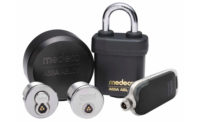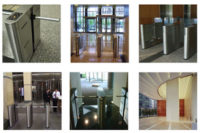Convergence is a big buzzword in the security industry these days. Traditionally it hasn’t been a word much associated with locks and hardware, but with the increased focus on power over Ethernet (PoE), wireless and sustainability, the elements that surround the electronic access control reader are now becoming an integral part of that technology package.
What’s more, these increasingly available options for installing locks, request-to-exit buttons and integrated locking systems are making it much easier on the integrator and lowering cost for the end user, opening up new opportunities for covering more doors.
“By simplifying the installation, we are hoping that more of the doors on the interior spaces will become opportunities to get another card reader on the door and it only takes 15 minutes to get up and running,” says Karen Keating, portfolio marketing manager for electronics, Allegion, Carmel, Ind.
“It was too cost prohibitive before,” adds Shane Geringer, vice president, Security Door Controls (SDC), Camarillo, Calif. “The past solution involved replacing all mechanical with brand new electrified hardware. Now we can take advantage of what is already there and electrify it to add it to the access system. This opens the door quite a bit for the integrators.”
Closing the Technology Gap
As buildings have gotten “smarter” so has the technology that goes in and around them.
“More buildings are becoming IP-based with more and more networked locations and items.” says Peter Boriskin, director of product management for commercial electronic access control, ASSA ABLOY, New Haven, Conn.
What this means on the lock and hardware end is that manufacturers are developing and retooling products to work directly with IP, PoE or the wireless network of the building.
“There is a strong desire to leverage the structured cabling and PoE already in the wall,” Boriskin adds.
However, simpler connections can mean more complex products, adds Keith Lathrop, business development manager, Midwest Wholesale Hardware, Kansas City, Mo. “Wiring and installation has gotten easier, but the equipment itself is a little more complex and robust. It used to be an electrified hinge meant two or four wires. Now it is two to 12 wires and you have to have the right connectors. There is product knowledge required that wasn’t there before.”
Integrator David Alessandrini, vice president, Pasek Corp., Boston, sees a definite trend to “converging” the mechanical with the network. “It is there, it is prevalent and we are seeing more and more of it. Systems are being designed that way by engineers because they are network compatible. Everything in the building is connected, from door, to desk to energy management systems.”
To that end, manufacturers are stepping up with offerings designed to make this transition easier on both the end user and the integrator/installer.
“We are looking at things from an overall connectivity and intelligence perspective,” Keating says. “Our goal is to make controlling and managing the opening as easy and efficient as possible.”
Still, there is a learning curve, particularly when a traditional hardware installer is now faced with an IP-based installation. SDC recently introduced its Web-enabled IP Pro door controller to help bridge that gap. “Our message to the hardware guys is they don’t have to be fully versatile on the IT side. Put this in, it is all vetted and it won’t mess anything up and can be easily integrated into the system,” adds Keating.
Whether the integrator does the door hardware installation themselves or contracts it out, this convergence of hardware and software will have a big impact on
Working SmarterThe range of options to wire a door and the hardware around it is much broader than it used to be. That means the integrator has to know more about what they are doing and how they will do it — and when to ask for help. “The market has changed drastically for the integrator,” Lathrop says. “If you go back 10 years they had to worry about the electric strike on the door and the card reader on the wall. Now there are electrified hinges, race cables and in general much more concern about getting an accurate bill of material. Companies like ours can help them create this.” Knowing what you need can be the biggest challenge, agrees integrator Shawn Sharp, Kingdom Security. “Knowing the difference between mortise and cylindrical, crash bar and rim — this is where my sales guys get tripped up the most,” he says. Manufactures and wholesalers are excellent resources for integrators, whether for training, design or just emergency ‘help’ calls. Tony Diodato, chief technology officer and founder, Cypress Integrated Solutions, is no stranger to calls for help. “A lot of these guys are experts in physical locks but then they run into trouble with how many wires they need or they are not quite the standard they are used to. We get a lot of calls on how to get from point A to point B,” Diodato shares. Sometimes the best defense is a good offense, and when it comes to hardware and locks, that means asking for help before you need it in the field. Many manufacturers offer pre-wiring services on their doors or hinges, or help with design. “We have a system design function,” Lecka details. “Integrators can tell us what they are using and what they are trying to do and we will come back to them with a solution that works with the total project.” ASSA ABLOY can prepare doors for deployment with a template, wiring, fire rating and more, according to Boriskin. “We have a team of specification specialists who will work with the integrator to ensure the design is appropriate and will meet certifications. We are not an integrator or an architect. We see our role in the specification and installation of products as developing products and services that help those partners be as successful as possible.” |
everyone, says Integrator Shawn Sharp, managing member, Kingdom Security LLC, LaPorte, Texas. “We have a locksmith division, but many integrators I know still hire a locksmith. Now it is really almost becoming one field. You have to know one to do the other.”
Easier for All
Wireless, PoE, consolidated wiring products — these are what manufacturers are focusing their efforts on today.
Conventional wiring of all the elements that make up a door control system can get up to 100 wires. Some manufactures are trying to help simplify things.
For example, Allegion offers a connector system for its wired products that color codes and makes the wires plug and play. “The connector system allows the installer to do more openings and faster than they normally would,” says Brent Kiernan, business unit leader for systems components, Allegion.
Cypress Integration Solutions, Lapeer, Mich., offers interface modules and controllers that allow the manufacturer’s door hardware to communicate to the panel in multiple ways. “Traditionally you would have to directly control it by dragging two wires back to the control panel, then seven more wires connected to the reader and yet more wires for ancillary things like door contacts,” says Tony Diodato, chief technology officer and founder, Cypress. “We pull all of that together on the secure side of the door and bring it back to the control panel.” This can be achieved wirelessly, via PoE or any other power source.
Request-to-exit button manufacturer, Safety Technology International (STI) has also gone wireless with their products, including a Universal Button capable of working in any situation. “It is all part of this trend of making things easier,” says Frank Soehnlein, national sales manager, STI, Waterford, Mich.
Going GreenOne of the side benefits of the low power momentum, PoE and wireless, is that the “green” or sustainable requirements that are increasingly popular with businesses now reach all the way down to the electronic hardware and lock. “When it comes to Leadership in Energy and Environmental Design (LEED) certifications, there were traditionally better opportunities regarding recycled materials relating to all products or building materials,” says Brent Kiernan, Allegion. “Now that we are starting to look at more efficiency and low power there is more opportunity to drive a bigger piece of the power usage regarding LEED benefits.” Low power and green initiatives matter more to certain segments of the market than others, says David Alessandrini, Pasek Corp. “It is a pretty big trend now. On many of our jobs the contractors have it in their certifications and build to those standards. Typically security hasn’t been able to contribute much to LEED certification, but now more and more things can be included.” Some lock manufacturers are specifically designing for sustainability and low power. ASSA ABLOY’s Ecoflex line offers an electrified mortise lock that uses 96 percent less power than its predecessor, says Peter Boriskin, ASSA ABLOY. “It represents $15 per door, per year savings. When you add the brand new EcoPower power supply it uses 98 percent less power.” Particularly for larger installations where economy of scale applies, green and low power can be sales buzzwords, says Midwest Wholesale Hardware’s Keith Lathrop. “Building owners and managers have become much more conscious of the environmental impact from both manufacturing process and power consumption.” Still, the security component of this is in its infancy. Some manufacturers and integrators report no requests at all where others say it is important. Perhaps the best way to think about it is as a tool in your pocket. “For us the primary driver has been fire/life safety/compliance, says Kerby Lecka, SDC. “It needs to work and meet all those requirements. Then we will have some folks come in and it is the icing on the cake that it can work into a green solution. We don’t generally lead with that, though.” SDC’s Shane Geringer thinks it can be on the mark with end users, however. “Energy efficiency equates to cost savings and they are always looking for that.” |
Integrated locks, which combine the reader, lock, door position sensor, and request-to-exit all built into the lock, make life easier for the installer and provide an opportunity for covering more door openings.
“You just pull it out of the box and put it on the door,” says Scott Lowder, product manager for electronic access control, ASSA ABLOY. “A mechanical installer could just show up on site, make a single connection and have the ability to test it to certify that everything is working so when an integrator shows up later they can have a high confidence it was installed correctly.”
Many of these types of locks work wirelessly, further cutting down on installation issues, Keating says. “With our new wireless lock an installer is able to take a cylindrical lock off the door and replace it with a new electronic cylindrical wireless lock in 10 minutes or so.”
Not everyone likes wireless, though, Alessandrini says. “Certainly from an installation standpoint we want it to be as cost effective as possible. But there is some pushback on wireless because people don’t like the battery operated aspect.”
With PoE, many of the same easy installation benefits apply, but the unit is still wired. By tapping into the nearest Ethernet connection, the installer can wire locks and devices without long cable runs — as long as the lock or device is low powered.
“Our AD locks have a PoE solution,” Kiernan says. “We are learning how to best take advantage of whatever infrastructure is in the building. In some cases that may be a wireless and in others it is sustainable power.”
SDC is also following the PoE trend, says Kerby Lecka, marketing officer, SDC. “The world is wired. Internet cable is everywhere. There are a lot of cost savings in not having to run power supplies for every door. In our case we didn’t have to redo any of our products. We were already low voltage, so we went about making sure they would work on PoE.”
Wireless and PoE are two trends that definitely make life easier, Sharp says. “That is the direction things are going. You drop the lock, terminate the unit and plug it in. With PoE you can run your panel and everything straight off the switch. In my opinion if a manufacturer doesn’t pick up on this they won’t be around in 20 years.”








